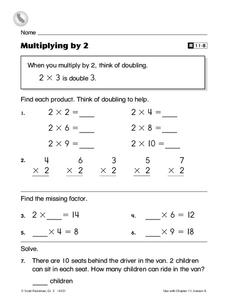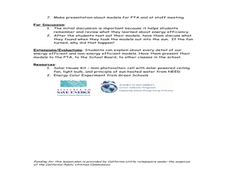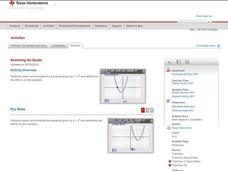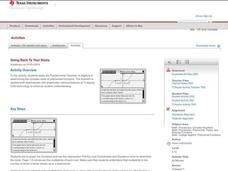Curated OER
Polygon Division Models
Learners use polygons to explore division. They use pattern blocks to represent whole numbers and fractions. They discuss divisors, factors, dividend and products. In groups, students present models and solve problems. They justify their...
Curated OER
Exploring Regions of Our World
Examine how climate and landforms affect plants and animals that live in particular areas. Discover that these same factors affect peoples' homes, jobs, and recreational activities. Pupils research ecosystems and biomes, and then write...
Curated OER
Population Biology Case Study
Students are focused on the big question: What makes a population grow and how could that growth stop? They use these concepts to help answer the big question: carry capacity, density dependent v. density, independent factors, predation...
Curated OER
Sand Explorations
Students experiment with different samples of sand from Maui leeward and windward beaches. They create a sand map to suggest at least one contributing factor for the formation of each beach sample. They test the samples to determine...
Curated OER
Demanding Celebs: Business Studies
Celebrities and economics? Business or economics classes discuss how different celebrities' stocks have been affected by supply and demand. They track the news to identify factors that impact value, discuss and justify their choice of...
Curated OER
Adolescent Nutrition Scenario Worksheet
Not everyone has the exact same health needs- but what are the influencial factors? This activity breaks down nutritional requirements (RDA) through 4 different scenarios depicting different adolescents. Students answer questions about...
Savvas Learning
Multiplying By 2
In this multiplication worksheet, math masters solve 10 fill-in-the-blank problems using the strategy of doubling. Next, answer four questions in which they find a missing factor in a multiplication problem. Finally, they try their hand...
Curated OER
Key Ingredients: America By Food
In this set of five lessons, students analyze the important of food traditions, identity, and history. Students analyze how food traditions contribute to family identity, investigate family food traditions through interviews, and compare...
Curated OER
Multiplying by 2 (B)
For this multiplying times two worksheet, students multiply factors from zero to nine times two horizontally. Students solve thirty-six problems.
Curated OER
Crafting Models of Efficiency
Students build and compare models of both an energy inefficient and efficient classroom. In this energy efficiency lesson, students creatively use recycled materials to build two separate classroom models. They factor in concepts such as...
Teach Engineering
Magnetic Resonance Imaging
The capstone activity in a 14-part series focuses on the basics of magnetic resonance imaging and the hardware of the machines. Pupils use this information and the material learned throughout the unit to develop a presentation on safety...
Curated OER
Demand and Supply—It’s What Economics Is About!
In this economics lesson, high schoolers examine the principle of supply and demand related to the oil market as they identify factors that cause curves and shifts and determine equilibrium. Upper graders read an informational article...
Curated OER
Stretching the Quads
Explore parabolas in this algebra lesson with the graphing calculator. The class investigates what effects the changing of the parameters of the vertex form of a quadrati have to its graph. They find the zeros of a quadratic graphically...
Curated OER
Going Back to Your Roots
Investigate the Fundamental Theorem of Algebra and explore polynomial equations to determine the number of factors, the number of roots, and investigate multiplicity of roots.
Center for Civic Education
To Amend or Not to Amend, That's Been the Question...Many Times
Looking for some ideas for how to celebrate September 17, Constitution Day? Check out a packet that focuses on the factors that are considered in the amendment process. Class members examine the amendment process and the types of...
Center for Civic Education
Historical Analysis of Constitutional Amendments
Each of the 27 Amendments to the U.S. Constitution were adopted within specific economic, political, social or cultural, and international contexts. As part of their Constitution Day/Week studies, seniors investigate these factors for...
Other popular searches
- Common Factors
- Factors of Production
- Biotic
- Factors and Multiples
- Abiotic and Biotic Factors
- Abiotic
- Factors That Affect Climate
- Abiotic Factors
- Limiting Factors
- Biotic Factors
- Greatest Common Factors
- Conversion Factors

















